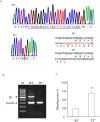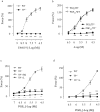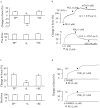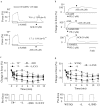Role of E-type prostaglandin receptor EP3 in the vasoconstrictor activity evoked by prostacyclin in thromboxane-prostanoid receptor deficient mice
- PMID: 28165064
- PMCID: PMC5292700
- DOI: 10.1038/srep42167
Role of E-type prostaglandin receptor EP3 in the vasoconstrictor activity evoked by prostacyclin in thromboxane-prostanoid receptor deficient mice
Abstract
Prostacyclin, also termed as prostaglandin I2 (PGI2), evokes contraction in vessels with limited expression of the prostacyclin receptor. Although the thromboxane-prostanoid receptor (TP) is proposed to mediate such a response of PGI2, other unknown receptor(s) might also be involved. TP knockout (TP-/-) mice were thus designed and used to test the hypothesis. Vessels, which normally show contraction to PGI2, were isolated for functional and biochemical analyses. Here, we showed that the contractile response evoked by PGI2 was indeed only partially abolished in the abdominal aorta of TP-/- mice. Interestingly, further antagonizing the E-type prostaglandin receptor EP3 removed the remaining contractile activity, resulting in relaxation evoked by PGI2 in such vessels of TP-/- mice. These results suggest that EP3 along with TP contributes to vasoconstrictor responses evoked by PGI2, and hence imply a novel mechanism for endothelial cyclooxygenase metabolites (which consist mainly of PGI2) in regulating vascular functions.
Conflict of interest statement
The authors declare no competing financial interests.
Figures






Similar articles
-
Increased role of E prostanoid receptor-3 in prostacyclin-evoked contractile activity of spontaneously hypertensive rat mesenteric resistance arteries.Sci Rep. 2017 Aug 21;7(1):8927. doi: 10.1038/s41598-017-09288-w. Sci Rep. 2017. PMID: 28827689 Free PMC article.
-
Differential properties of E prostanoid receptor-3 and thromboxane prostanoid receptor in activation by prostacyclin to evoke vasoconstrictor response in the mouse renal vasculature.FASEB J. 2020 Dec;34(12):16105-16116. doi: 10.1096/fj.202000845RR. Epub 2020 Oct 13. FASEB J. 2020. PMID: 33047360
-
TP and/or EP3 receptors mediate the vasoconstrictor and pressor responses of prostaglandin F2α in mice and/or humans.FASEB J. 2019 Feb;33(2):2451-2459. doi: 10.1096/fj.201801064RR. Epub 2018 Oct 2. FASEB J. 2019. PMID: 30277822
-
Targeting the Prostacyclin Pathway: Beyond Pulmonary Arterial Hypertension.Trends Pharmacol Sci. 2017 Jun;38(6):512-523. doi: 10.1016/j.tips.2017.03.003. Epub 2017 Apr 12. Trends Pharmacol Sci. 2017. PMID: 28412042 Review.
-
The endothelial cyclooxygenase pathway: Insights from mouse arteries.Eur J Pharmacol. 2016 Jun 5;780:148-58. doi: 10.1016/j.ejphar.2016.03.043. Epub 2016 Mar 26. Eur J Pharmacol. 2016. PMID: 27020548 Review.
Cited by
-
EP3 Blockade Adds to the Effect of TP Deficiency in Alleviating Endothelial Dysfunction in Atherosclerotic Mouse Aortas.Front Physiol. 2019 Sep 26;10:1247. doi: 10.3389/fphys.2019.01247. eCollection 2019. Front Physiol. 2019. PMID: 31611817 Free PMC article.
-
Endothelial cyclooxygenase-1 paradoxically drives local vasoconstriction and atherogenesis despite underpinning prostacyclin generation.Sci Adv. 2021 Mar 19;7(12):eabf6054. doi: 10.1126/sciadv.abf6054. Print 2021 Mar. Sci Adv. 2021. PMID: 33741600 Free PMC article.
-
Extracellular Histones Activate Endothelial NLRP3 Inflammasome and are Associated with a Severe Sepsis Phenotype.J Inflamm Res. 2022 Jul 25;15:4217-4238. doi: 10.2147/JIR.S363693. eCollection 2022. J Inflamm Res. 2022. PMID: 35915852 Free PMC article.
-
Increased role of E prostanoid receptor-3 in prostacyclin-evoked contractile activity of spontaneously hypertensive rat mesenteric resistance arteries.Sci Rep. 2017 Aug 21;7(1):8927. doi: 10.1038/s41598-017-09288-w. Sci Rep. 2017. PMID: 28827689 Free PMC article.
-
Inflammasomes: Pandora's box for sepsis.J Inflamm Res. 2018 Dec 11;11:477-502. doi: 10.2147/JIR.S178084. eCollection 2018. J Inflamm Res. 2018. PMID: 30588058 Free PMC article. Review.
References
-
- Bunting S., Gryglewski R., Moncada S. & Vane J. R. Arterial walls generate from prostaglandin endoperoxides a substance (prostaglandin X) which relaxes strips of mesenteric and coeliac ateries and inhibits platelet aggregation. Prostaglandins 12, 897–913 (1976). - PubMed
-
- Davidge S. T. Prostaglandin H synthase and vascular function. Circ Res 89, 650–660 (2001). - PubMed
-
- Needleman P. et al.. Identification of an enzyme in platelet microsomes which generates thromboxane A2 from prostaglandin endoperoxides. Nature 261, 558–560 (1976). - PubMed
-
- Smith W. L., DeWitt D. L. & Garavito R. M. Cyclooxygenases: structural, cellular, and molecular biology. Annu Rev Biochem 69, 145–182 (2000). - PubMed
Publication types
MeSH terms
Substances
LinkOut - more resources
Full Text Sources
Other Literature Sources
Molecular Biology Databases

